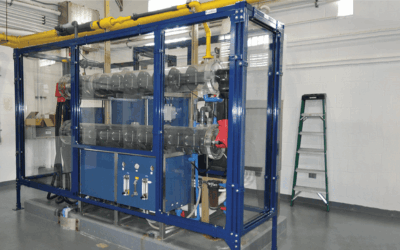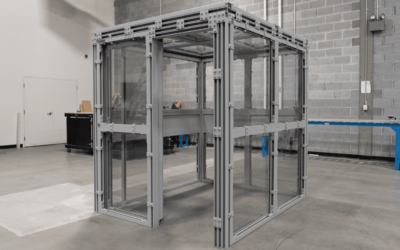Across industries, prioritizing safety is critical. Shielding test enclosures serve as crucial safeguards, protecting against threats such as explosive blasts, overpressure, ballistic impacts, and other hazardous scenarios, guaranteeing the well-being of all involved. However, as leaders in the blast-resistant industry for over 20 years, here at TotalShield we know choosing the right shielding solution can be challenging. That’s where our team of expert engineers steps in.
Our engineers are dedicated to guiding you through every step of the decision-making process. We will assess all necessary considerations for our enclosure design to guarantee that you receive a fully customized shielding solution that meets your requirements and specifications.
In this blog post, we’ll explore our five-step method and explain how our engineering team assists in each stage.
Step 1: Creating a blast-resistant enclosure conceptual design
The first step of our enclosure design process is conceptual design.
We work closely with our customers to understand their specific requirements and assess the maximum threat level they may face. This close collaboration allows us to define the most effective shielding product tailored to their safety needs.
Let’s take the aerospace industry as an example, where new rocket propulsion technology is developed daily. Blast-impact shielding is crucial to keeping personnel safe and maintaining industry standards without compromising project performance.
We have developed numerous high-impact resistance modular building models for large pneumatic, hydrostatic, rotational, explosive, and other hazardous tests requiring personnel and machinery access. We’ve also designed mobile enclosures ranging from 1.5’W x 1.5’L x 1.5’H (3.375 cu ft) to 4’W x 4’L x 4’H (64 cu ft) approximate outer dimensions.

Our shielding enclosures are also crucial in the green energy sector, especially for electrolyzer manufacturers. They play a vital role in protecting staff from unexpected pneumatic and hydrostatic pressure test failures that could cause significant damage due to their large design, high liquid and gas volume, and the elevated energy transferred to various potential projectiles like fittings, plugs, caps, manifold, gauges, pipes, and shrapnel.
Recently, we have received various inquiries from electric vehicle makers seeking protection against thermal runaways and toxic fumes caused by battery failures. We design shielded enclosures to offer protection from flames with minimal heat transfer to the exterior, adaptive vented panels, temperature or manually activated fire suppression systems, and E-lock integration, ensuring total visibility during events and allowing our customers to take reactive actions to mitigate the immediate threat.
As you can see, our engineering team brings years of expertise to the table, ensuring that the proposed solutions meet and exceed expectations regarding safety and performance.
Step 2: Selecting the blast-resistant enclosure material
Once the conceptual design is done, we select the proper shielding material and framing design. Our team carefully considers each client’s unique needs, including factors such as:
- worst-case threat scenario
- budget and footprint constraints
- project lead time execution
- environmental conditions
- desired performance levels
Through a meticulous selection process, we ensure that the chosen materials and framing structure offer optimal protection without compromising functionality. Even if we use the same materials for different solutions, their purpose will define the specifics.

For instance, pneumatic test setups with the same volume, size, and maximum pressure may require various polycarbonate thicknesses. Specific components, such as a filter dryer, hose, or quick connector, could have greater mass and dimensions, resulting in higher impact energy density and an increased risk of ballistic penetration.
Hydrostatic testing historically presents a lower risk than pneumatic tests, but each case should be evaluated individually. For example, a single unit may have multiple projectiles with low-impact energy, requiring a 0.5” polycarbonate thickness for protection. However, the required thickness would increase if one of the projectiles has extended thread engagement to withstand higher pressure and generate more kinetic energy upon failure.
That is why we must understand our clients’ machinery and testing procedures. Even if they seem similar, each industrial setting can pose a worst-case scenario.
Step 3: Product safety testing
We evaluate the proposed shielding solution’s performance in the proof testing phase. Our Testing Archive is a valuable resource that provides us with over 20 years of testing data to inform our decisions.
In cases where specific test procedures lack previous data, our engineering team assists in developing a customized test plan and oversees proof tests at approved facilities.
This ensures that our modular enclosures meet the required performance standards and provide the desired level of protection.
Step 4: Manufacturing your blast-rated enclosure

Our team springs into action once the design is approved to bring it to life. With precision and attention to detail, we manufacture our shielding products according to the approved design specifications.
Our manufacturing facilities ensure consistent quality and adherence to industry standards, giving our customers peace of mind knowing that their shielding enclosures are in capable hands.
Our designs, fabrications, and assemblies are proudly made in the USA, ensuring a world-class product.
Step 5: Delivering your shielding solution
We deliver the shielding solutions directly to our customers. Along with the products, all our customers receive a Letter Report detailing their shielding solution’s specifications, blast or ballistic calculations, and performance characteristics.
Additionally, we provide detailed instructions for installation and care and use manuals to guarantee that our customers can effectively deploy and maintain their safety enclosures.

TotalShield’s engineering team is key in guiding our customers through each step of the decision-making process. From conceptual design to product delivery, our commitment to safety guarantees that our customers receive a tailored solution that meets their needs.
But our dedication does not end here. We provide ongoing support to our customers to make sure that their impact-resistant enclosures and modular buildings continue to perform optimally for years to come.
With TotalShield’s team by your side, you can confidently navigate the complexities of shielding solutions, knowing that the safety of your personnel and equipment is in capable hands.








![The Pneumatic Pressure Testing Handbook [Part 3]: Pneumatic Testing Safety](https://totalshield.com/wp-content/uploads/2024/07/blog-cover-pressure-testing-safety-400x250.png)
![The Pneumatic Pressure Testing Handbook [Part 2]: Pneumatic Testing Requirements](https://totalshield.com/wp-content/uploads/2024/07/blog-cover-pipes-pressure-testing-400x250.png)
